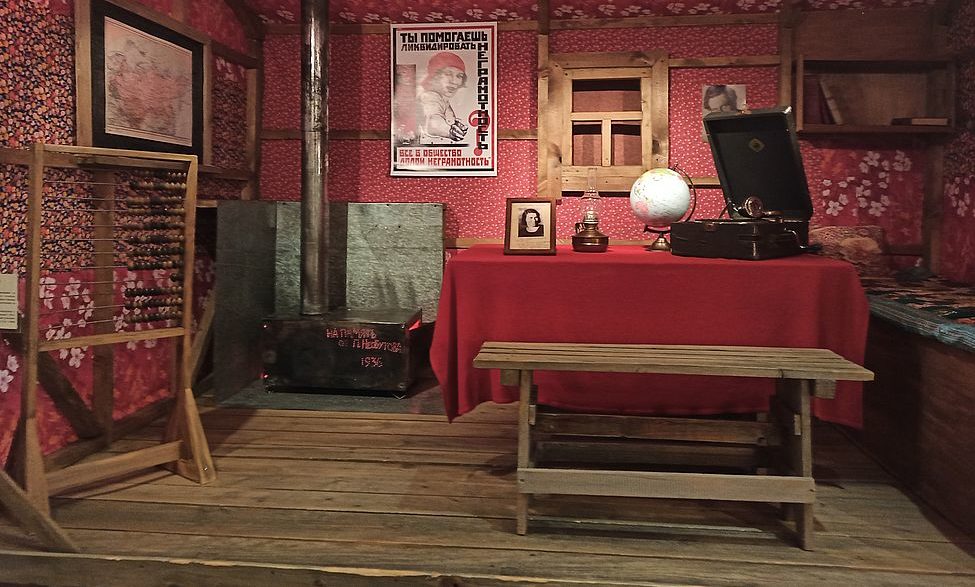After the publication of the book My Friends Nganasans Taimyr became the dream of many pedagogical universities graduates. This is how Olga Hakimulina, Candidate of Historical Sciences, who had been teaching history and culture of indigenous peoples at the Norilsk Industrial Institute for almost a quarter of a century, came to the North. After reading Hazanovich’s book as a fourth-year student at Saratov University, she asked to send her to the tundra. And there were many such examples.
“The sun is in a hurry to say goodbye to the earth. It has nothing to do now. The soft, fluffy blanket of a snowy winter will warm the earth. The luminary quickly runs around a small circle across the sky and, pausing for a moment, falls into the distant horizon. We have so little of its light that we catch the dawn when people are supposed to still sleep. We open the entrances to the chum from the south, then from the north…”
This entry in the diary, which became the basis of the future book, was left by the 25-year-old mistress of the Red Chum on September 27, 1937, after a summer wandering in the tundra with the Nganasans. Amalia Hazanovich’s diary entries helped the museum workers in Dudinka to recreate a nomadic cultural institution typical of the 1930s for northerners. Two nomadic years in the Taimyr tundra, in 1936-1937, first with the Dolgans, and then with the Nganasans, determined the rest of Amalia Hazanovich’s life.
She decided to work in the Arctic at the age of 21, responding to the first call of the Komsomol members. The girl did not get into the first hundred who went to the North in 1934. However, a letter sent to Komsomolskaya Pravda newspaper, where the young toolmaker from one of the Moscow factories reported that she could carry out cultural work among the natives of the North, did not stay unnoticed. Hazanovich received an offer to go to Taimyr to the Khatanga cultural base from the head of the Red Chum in May 1936, and in June she was already sailing on a steamer along the Yenisey with the artists of the Maly Theater led by Vera Pashennaya. As you know, the Maly Theater went on tour to Igarka, where the First Polar Theater appeared in the same year. There, on the steamer, Amalia met a journalist, writer Georgy Kublitsky, who remembered her as ‘a girl with a fast speech, mocking eyes behind the bulging glasses in a horn frame’.
In 43 years, Amalia Hazanovich’s glasses will become a museum piece. Of course, not the ones from 1936, and not in a horn, but in a metal frame. The guest of Dudinka will hand them over to the Taimyr Local Lore Museum on one of her visits in 1979. Khatanga was more fortunate with the originals. The first teacher of Taimyr bequeathed a part of her personal library, which also contained books that roamed with her in the tundra, to the Khatanga school.
For the Red Chum, Hazanovich took with her not only textbooks, visual aids, but also various board games, a volleyball with a net, a gramophone with records, as well as a small-caliber rifle with cartridges. All this is reproduced in the museum project of the Taimyr Museum of Local Lore using items from different collections.
The head of the Red Chum, Amalia Hazanovich, not only educated, but also treated her wards, sharing their nomadic life with them. Newspapers wrote about her, calling her ‘amazing, courageous, selfless, giving all her strength to the enlightenment of the indigenous people.
Two seasons of Amalia Hazanovich turned into 15 years of service to the Arctic. First, in the political department of Glavsevmorput. During the war years, Hazanovich worked as a collector in the Nordvik oil prospecting expedition, then she was a junior researcher at the Arctic Institute, worked as a meteorologist in the Khatanga expedition. After graduating from the Higher Economic Courses at the USSR State Planning Committee, from 1957 until her retirement, she held the post of senior economist at the Central Statistical Office of the RSFSR.
After Hazanovich’s death in 1986, an urn with her ashes was brought from Moscow to Khatanga. Part of the ashes was scattered from the helicopter, and the rest was buried in the village of Novaya. An inscription was made on the obelisk, which begins with the words: “We have come to you, Ama, your friends Nganasans…”
On the eve of the 100th anniversary of Amalia Hazanovich’s birth, the head of Taimyr at that time Sergey Baturin, inspired by the legendary educator, established the nomination called For loyalty to the profession.
“She was not afraid of the harsh climate of the Arctic, unknown and unresearched, and fulfilled her professional duty”, said Baturin, opening the traditional pedagogical conference. “Let the first Taimyr teacher become a symbol of loyalty to the profession for all teachers in Taimyr”.
Read about other historical witnesses in our Artefacts section.
Text: Valentina Vachaeva, Photo: Taimyr Museum of Local Lore






